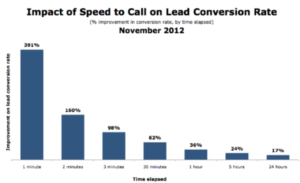To start, we need to understand why sales development is critical to the health of your revenue machine. There are eight compelling reasons to build or outsource a sales development organization.
1. Connecting with prospects requires time and resources
To understand how much effort it takes to reach a prospect by phone, look at these numbers.
- Dials-to-connects – It takes 12.73 dials to get a connect when calling a list of prospects with direct phone numbers and 18.83 when calling switchboard numbers.
- Dials to Conversation – 22.5 dials to meaningful conversation is the industry average, but if you’re calling highly solicited divisions, such as IT or marketing, or very senior executives the number is closer to 30 dials to 1 conversation.
- Conversation to Appointment – 3 meaningful conversations are required to get 1 appointment.
To sum it up: it can take 60-90 dials to get an appointment with a prospect which is not an efficient use of a quota-carrying sales person’s time.
2. A fast, standardized lead follow-up process is the key to conversion
If we continue to use the numbers provided in bullet #1, then you can also assume that it takes more than 12 touches to reach an individual prospect. Furthermore, Sales Benchmark Index research finds that 70% of buyers prefer to work digitally. In other words, a sales person will not only have to make a lot of dials, but will also need to incorporate email and potentially social touches. As a matter of fact, we have found that combining digital touches with the phone generates higher touch-to-connect conversion rates. Quota-carrying sales reps do not have the bandwidth to manage the multi-channel campaign necessary to reach leads.
Another factor to consider is your lead response time. The following chart highlights the challenge and opportunity presented by response rates. The faster you respond to an inbound lead, the higher the conversion. At the end of day, a quota-carrying sales person who is responsible for the other 70% of a sales cycle for multiple deals cannot feasibly meet the required follow-up rates.
3. Converting a lead to an opportunity requires its own playbook and subsequent training and coaching
Sales development is fundamentally different than the rest of the sales cycle. The science of connecting with someone is hard enough, but when you connect, you have a few seconds to generate interest and a couple minutes to handle objections and close for a meeting. Effective sales development requires full-time management, specific training, and constant coaching.
4. Sales Development means a higher lead to opportunity conversion
Converting a lead takes time and effort. The best revenue machines have a sales development group to reach leads, overcome objections, make sure they are a fit, and get them connected to sales teams. From 2007-2015, the principals of SalesPro founded and operated a company called Growth Experts. At Growth Experts they would use a variety of digital marketing tactics to generate leads for 100s of clients. When they looked across all their clients, the organizations with sales development teams converted leads to opportunities at an exponentially higher rate than those that did not. For example, they had two technology clients who sold competitive solutions to the same type of buyer. The company with an optimized sales development converted these leads at greater than 45%. The other organization passed leads directly to their quota-carrying sales associates and converted leads at less than 6%.
5. Marketing and contact data is vastly improved with sales development
Marketing can only optimize programs if they have the data they need to be successful. Sales reps are notoriously bad at maintaining good data and sales leadership cares about sales forecast data (with good reason). On the other hand, well managed sales development teams are remarkably good at providing data. Sales development teams literally “live” in the CRM application all day and are incented to get good data to marketing to make their lives easier.
6. Sales and marketing alignment
The biggest grievance from marketing is the fact that sales doesn’t follow up on their leads. Meanwhile the single biggest complaint from sales is that marketing leads are terrible. Sales development teams help bridge the gap between sales and marketing. When managed correctly, sales development solves lead follow-up issues. As for the issue of marketing’s leads “sucking”, this problem often happens when unqualified leads are sent directly to quota-carrying sales reps. The truth is that the vast majority of leads do “suck”. A very good conversion rate is 30% from lead-to-opportunity which means that 70% of the leads contacted won’t turn into anything. Quota-carrying sales reps don’t have the time to expend the effort needed to reach these leads only to find that 70% will turn into nothing. Sales development solves this problem by sending sales only qualified leads ready to talk.
7. Increased productivity and efficiency from quota-carrying sales reps = more revenue
Sales reps are expensive resources that you pay to close business – you have to free up their time to focus on the effort needed to achieve their goals. A great quota-carrying sales person is spending the majority of their day working the rest of the sales cycle: pitching, proposing, negotiating, trying to get buyers back on the phone, meeting with internal stakeholders, etc… We increase the odds of closing more business by allowing sales to begin their sales process with qualified leads who are ready to speak to sales.
The Marketo Definitive Guide to Leads Qualification and Sales Development provides compelling data highlighting the benefits of sales development to sales reps including a:
- 5% increase in selling time that can yield a 20% increase in revenue;
- 1% increase in pipeline value that can yield a 25% increase in revenue; and
- 15% decrease in sales cycle length that can yield a 30% increase in revenue.
8. Your buyer wants you to follow-up
In our research, we will often find buyers who filled out forms on vendor websites and then will actually complain that “no one followed up with them.” When we look at the data, the vendor actually had followed up. The problem was the sales rep sent one unremarkable email as “follow-up” and never reached back out. Believe it or not, well messaged, thoughtful yet persistent follow-up is part of a great buying experience. Buyers are extremely busy. They aren’t always ignoring your phone calls because they aren’t interested. Recently, I finally connected with a prospect I had been calling and emailing for three weeks who said: “Thanks for staying on top of this, I have been meaning to get back to you.”
A couple years ago I listened to a panel that featured IT leaders talking about what they expected from sales people. Andrew Baker, at the time a Director of IT Operations, said: “I want you to qualify me well so we both know whether we are wasting each other’s time. If it’s something relevant to me, I will want to know about it.” Some people may find this surprising, but proper qualification is actually an important point in the buying experience.
The case for sales development is extremely compelling. The case for outsourcing it to an expert vendor is equally as compelling.
For more information on this topic download our White Paper on The Case for Sales Development.






Leave A Comment